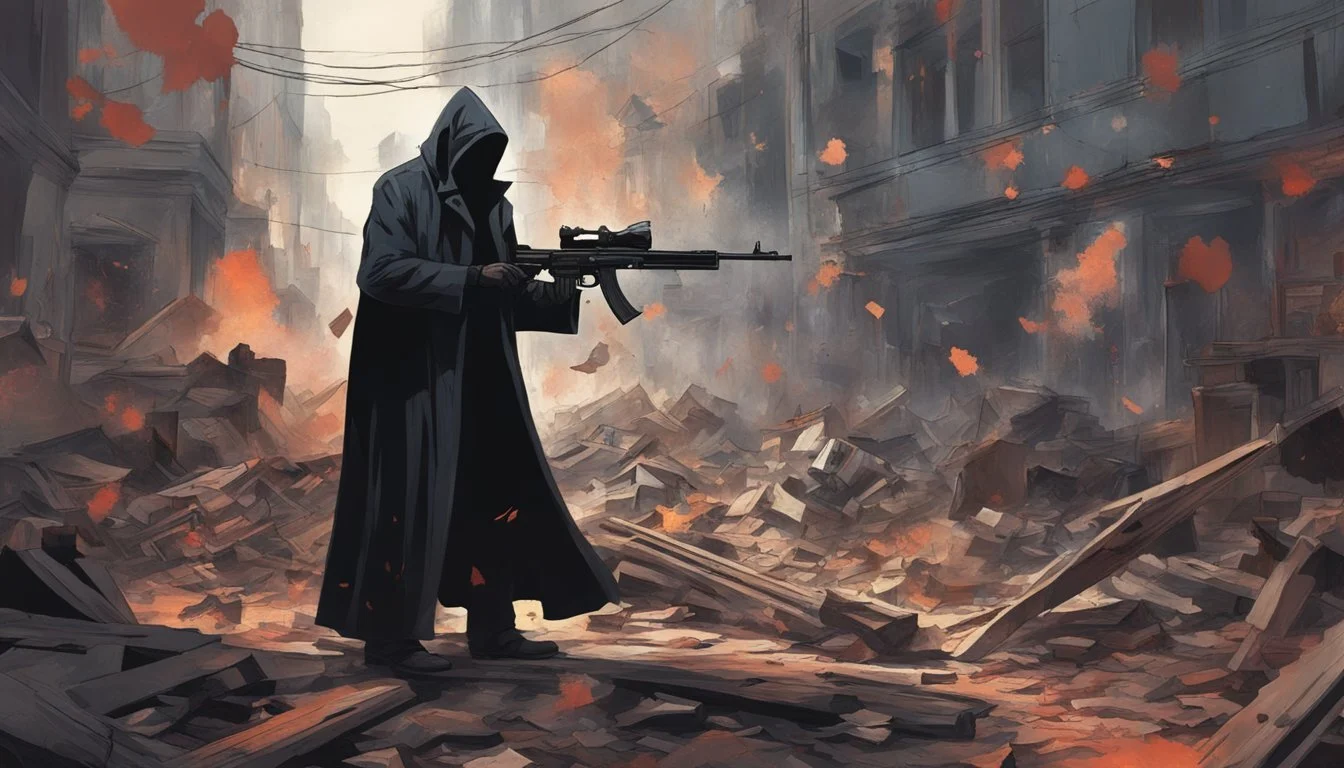Shocking Reenactments: How 'The Act of Killing' Forces Us to Face Dark Truths
"The Act of Killing" is a groundbreaking 2012 documentary that challenges our understanding of history, morality, and human nature. Directed by Joshua Oppenheimer, the film explores the aftermath of the Indonesian mass killings of 1965-66 through a unique and unsettling lens.
The documentary follows former death squad leaders as they reenact their past atrocities in various cinematic styles, from classic Hollywood crime scenes to lavish musical numbers. This unconventional approach allows viewers to witness the perpetrators grappling with their actions, revealing complex emotions and rationalizations.
The film raises profound questions about impunity, the construction of historical narratives, and the lasting impact of violence on society. It has garnered critical acclaim, winning numerous awards including Best Documentary at the 67th BAFTA Awards. "The Act of Killing" serves as a powerful reminder of the importance of confronting difficult truths and the role of cinema in exploring complex human experiences.
Conceptualization and Development
Joshua Oppenheimer's groundbreaking documentary "The Act of Killing" emerged from years of research and collaboration with Indonesian survivors and perpetrators. The project's unique approach challenged traditional documentary filmmaking methods.
Origins and Inspiration
Joshua Oppenheimer began exploring the 1965-66 Indonesian genocides in 2001. His initial work involved filming survivors, living among them for a year in a village outside Medan. This immersive experience provided crucial insights into the long-lasting impact of the killings on Indonesian society.
Oppenheimer's approach shifted when he encountered difficulties documenting survivors' stories due to ongoing intimidation. He then turned his focus to the perpetrators, who spoke openly and even boastfully about their actions. This unexpected openness inspired the film's unconventional concept of asking killers to reenact their crimes.
Creative Team and Production
The documentary's creative team included co-directors Christine Cynn and an anonymous Indonesian filmmaker. Producer Signe Byrge Sørensen played a crucial role in supporting the project's development and execution.
Production began in 2005 and continued for several years. The team worked closely with former death squad leaders, building relationships that allowed for the film's unique reenactment approach. This method involved the perpetrators creating cinematic scenes based on their memories and fantasies of the killings.
The filmmakers faced significant challenges, including safety concerns for the Indonesian crew members. They had to navigate complex ethical considerations while pushing the boundaries of documentary filmmaking.
Synopsis of the Documentary
"The Act of Killing" is a 2012 documentary directed by Joshua Oppenheimer. It focuses on the Indonesian mass killings of 1965-66, a dark period in the country's history.
The film's central figure is Anwar Congo, a former leader of an Indonesian death squad. Congo and his associates were responsible for countless murders during the anti-communist purge.
Oppenheimer takes an unconventional approach to storytelling. He invites Congo and other perpetrators to reenact their crimes through various cinematic genres.
These reenactments range from Hollywood-style gangster scenes to elaborate musical numbers. The killers eagerly participate, often boasting about their past actions.
As the film progresses, the line between reality and fiction blurs. The perpetrators begin to confront the gravity of their actions through these dramatizations.
The documentary does not shy away from depicting disturbing content. It presents graphic discussions and representations of violence committed during the killings.
"The Act of Killing" provides a unique perspective on historical atrocities. It explores the psychology of the perpetrators and the lasting impact of their actions on Indonesian society.
The film sparked controversy and debate upon its release. It raised questions about impunity, historical memory, and the nature of evil.
Critical Analysis of Content
The Act of Killing offers a chilling examination of mass murder, violence, and impunity through innovative documentary techniques. Its unflinching look at perpetrators challenges viewers and raises complex ethical questions.
Portrayal of Death Squad Leaders
The film's central figures are former death squad leaders who openly discuss their roles in the 1965-66 Indonesian genocide. These men show little remorse, often boasting about their brutal acts. Their casual attitudes toward violence are jarring.
The documentary allows perpetrators to reenact killings, revealing disturbing mindsets. Some leaders express pride in their methods, while others seem detached from the gravity of their actions.
By giving killers a platform, the film risks humanizing them. However, it also exposes the banality of evil and the lasting effects of impunity.
Reenactments and Their Impact
The Act of Killing's most controversial element is its use of reenactments. Perpetrators stage elaborate recreations of their crimes, often in the style of Hollywood genres.
These surreal scenes blur lines between reality and fiction. They provide insight into how killers rationalize their actions through cultural narratives and self-mythologizing.
The reenactments serve as a form of confrontation. Some participants show signs of emotional distress when forced to play victims.
Critics argue these scenes are exploitative. Supporters claim they reveal psychological truths about violence and memory.
Themes of Power and Corruption
The documentary explores how unchecked power leads to corruption and violence. It shows how perpetrators maintained influence in Indonesian society long after the genocide.
Political and economic systems are portrayed as deeply compromised. The film suggests a culture of impunity allowed killers to thrive.
Interviews reveal how fear and propaganda were used to justify mass murder. The documentary draws connections between past atrocities and ongoing corruption.
By focusing on perpetrators rather than victims, the film offers a unique perspective on how societies grapple with historical trauma.
Public and Critical Reception
The Act of Killing received widespread acclaim and recognition from audiences and critics alike. Its innovative approach to documentary filmmaking sparked discussions about historical trauma and ethical storytelling.
Award Nominations and Wins
The film garnered numerous prestigious accolades. It earned a nomination for Best Documentary Feature at the 86th Academy Awards in 2014. The European Film Awards honored it with the Best Documentary prize.
The Act of Killing premiered at the 2012 Toronto International Film Festival, launching its successful run on the festival circuit. It collected awards at various international film festivals, solidifying its status as a groundbreaking work.
Critical Reviews and Rankings
Critics praised the documentary for its daring approach and thought-provoking content. Many reviewers considered it one of the best films of 2013, citing its unique exploration of historical events through reenactments.
The film's unflinching portrayal of perpetrators and its examination of collective memory resonated with critics. It appeared on numerous year-end lists of top films, earning spots in both documentary and overall film categories.
Reviews often highlighted the documentary's ability to provoke uncomfortable yet necessary conversations about past atrocities and their lasting impact on society.
Cultural and Historical Context
The Act of Killing explores Indonesia's dark past, shedding light on the 1965-66 mass killings. This documentary sparked conversations about historical memory and national identity.
Impact on Indonesian Society
The film challenged Indonesia's official narrative of the 1965-66 events. It exposed the lingering trauma and unresolved tensions in Indonesian society. Many Indonesians were unaware of the full extent of the atrocities.
The documentary prompted some to confront this painful history for the first time. It sparked debates about accountability and reconciliation. Some viewed it as a necessary step towards healing.
Others criticized the film for reopening old wounds. They argued it could destabilize the country's fragile peace. The government initially banned public screenings in Indonesia.
International Response
The Act of Killing garnered significant attention abroad. It raised awareness of Indonesia's past among international audiences. The film received numerous awards and critical acclaim.
US Congress members called for further investigation into the mass killings. This put pressure on Indonesia to address its history. Human rights organizations used the film to advocate for justice.
Some critics questioned the ethics of the film's approach. They debated whether reenactments by perpetrators were appropriate. Others praised its innovative storytelling techniques.
The documentary became a tool for education and advocacy. It prompted discussions about historical memory in other post-conflict societies.
Influence and Legacy
"The Act of Killing" transformed documentary filmmaking with its innovative approach to exploring historical trauma. The film's use of reenactments by perpetrators sparked discussions about ethical filmmaking practices.
Its impact extended beyond cinema, influencing public discourse on Indonesia's past and present. The documentary received critical acclaim, earning an Asia Pacific Screen Award and an Academy Award nomination for Best Documentary Feature.
The film's Director's Cut further expanded its reach, providing additional context and depth to the already powerful narrative. This version solidified the documentary's place in cinematic history.
"The Act of Killing" inspired other filmmakers to experiment with unconventional storytelling techniques. It demonstrated the potential of documentaries to challenge audiences and confront uncomfortable truths.
The production company Final Cut For Real gained recognition for its bold approach to documentary filmmaking. This project set a new standard for addressing complex historical events through cinema.
The film's legacy continues to resonate in academic circles, where it is studied for its unique methodology and ethical implications. It remains a touchstone for discussions about representation, memory, and reconciliation in post-conflict societies.
Production Details and Techniques
The Act of Killing employed innovative documentary techniques to explore the psychology of mass murderers. Director Joshua Oppenheimer used unconventional methods to engage with perpetrators and capture their perspectives on past atrocities.
Directorial Approach
Oppenheimer took an unorthodox approach by inviting Indonesian death squad leaders to reenact their killings on camera. He encouraged them to dramatize their memories in the style of their favorite Hollywood genres. This technique aimed to reveal the perpetrators' mindsets and rationalizations.
The director spent years building relationships with the subjects before filming. He gained their trust and cooperation, allowing for candid discussions about their violent pasts. Oppenheimer's patient, non-judgmental approach created an environment where the killers felt comfortable expressing themselves openly.
Cinematography and Editing
The film's visual style blends raw documentary footage with surreal, stylized reenactments. Cinematographer Carlos Arango de Montis captured both everyday scenes and elaborate fantasy sequences. The contrast between these elements heightens the unsettling nature of the subject matter.
Editors Niels Pagh Andersen and Janus Billeskov Jansen crafted a non-linear narrative structure. They interwove present-day interviews, reenactments, and behind-the-scenes moments. This approach creates a disorienting effect, mirroring the psychological complexity of the perpetrators' stories.
The film's look was influenced by the work of Werner Herzog and Errol Morris, both known for pushing documentary boundaries. Their impact is evident in The Act of Killing's willingness to blur the line between reality and fiction to uncover deeper truths.
Screenings and Distribution
The Act of Killing gained significant attention through its strategic screenings and distribution. The film made waves at international festivals before reaching wider audiences through various release strategies.
Film Festival Circuit
The Act of Killing premiered at the 2012 Telluride Film Festival, marking the start of its festival journey. It went on to screen at numerous prestigious events, including human rights film festivals in Prague and other cities. These festival appearances helped generate buzz and critical acclaim for the documentary.
Special academic screenings further amplified the film's impact, particularly among scholars and activists. The documentary's unique approach to exploring historical violence sparked discussions in academic circles, contributing to its growing reputation.
International Releases and Versions
Multiple versions of The Act of Killing were released internationally. The theatrical cut ran 116 minutes, while a longer Director's Cut spanned 159 minutes. This extended version provided deeper insights into the film's subjects and themes.
Distribution strategies blended theatrical releases with digital platforms, broadening the film's reach. In Indonesia, where official distribution faced censorship challenges, unofficial channels emerged. These grassroots efforts allowed The Act of Killing to find audiences despite political obstacles.
The film's release on various digital platforms made it accessible to viewers beyond traditional documentary enthusiasts. This approach helped spread its message to a diverse global audience.







